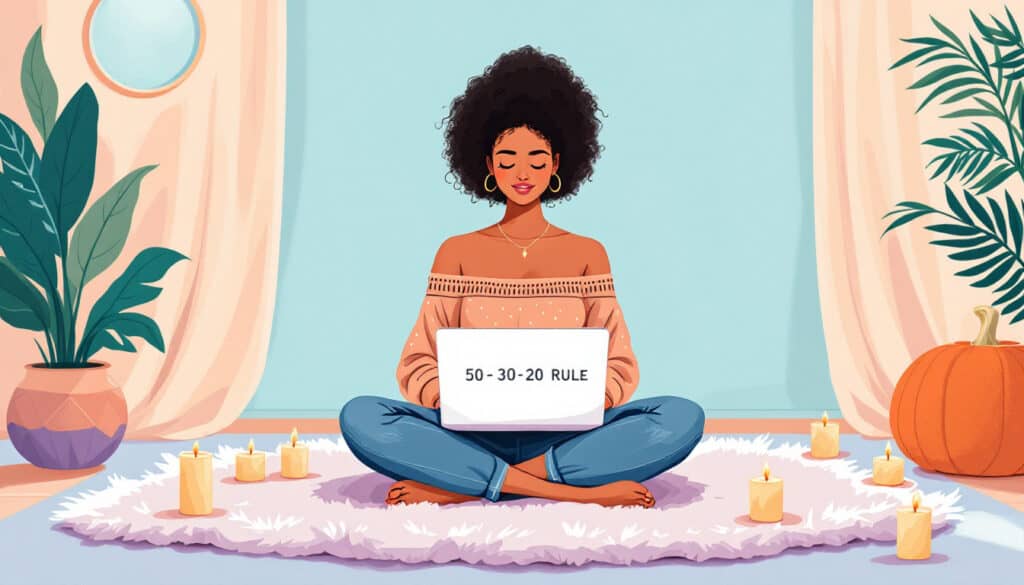Cutting back on spending should not feel like you’re giving up on life’s little joys.
I know that tightening your budget can sometimes feel like you’re trading happiness for financial peace.
But here’s the secret, living within your means is not ditching everything that makes you happy.
It’s about getting creative, prioritizing what truly matters, and finding those sweet spots where your wallet and your well-being align.
For example, shifting how you think about personal growth can make a world of difference.
If you need ideas, I found these simple self-love exercises incredibly helpful in building confidence and staying grounded.
And when it comes to creating a budget that’s empowering instead of limiting, check out this guide to budgeting with purpose for a fresh perspective.
Small, intentional changes can lead to big results, without the sacrifice.
How to Cut Your Expenses Without Giving Up What Makes You Happy
Identify Your Spending Triggers
Did you know that half the battle of cutting expenses is understanding why you spend in the first place?
Think about it. Those impulse purchases, little splurges, or “treat yourself” moments usually have deeper roots than just the swipe of a card.
The truth is, we all face spending triggers. Recognizing them is a key first step to financial freedom without feeling like you’re missing out.
Let’s break it down.
1. Track Your Expenses
You might think you know where every dollar goes, but unless you’re actively tracking your expenses, it’s easy to lose sight of reality.
Those morning lattes, Amazon clicks, or a last-minute dinner out can quietly add up.
Documenting your spending is like turning on the lights in a dim room. You finally see everything clearly.
Here’s how to start tracking:
- Use free budgeting apps like Mint, PocketGuard, or YNAB (You Need a Budget). They make it easy to sync bank accounts and categorize spending.
- Prefer a more hands-on approach? Grab a notebook or use an Excel sheet. Write down every single purchase. Yes, even that $2 gum you grabbed at the store.
- Review your expenses weekly. Patterns will emerge, helping you spot areas where you’re most likely to overspend.
Think this sounds simplistic? It’s the “simple” habits that often have the most transformative impact.
Tracking makes spending transparent, giving you the power to decide where your money really belongs.
Photo by Kaboompics.com
2. Recognize Emotional Purchases
Have you ever noticed how stress or boredom tends to lead you straight to your favorite online shop?
Emotional spending is so sneaky because it’s tied to our feelings, not our needs.
Whether it’s cheering yourself up after a tough day or buying something “just because,” these purchases can quietly derail your financial goals.
Here are some better ways to cope when emotions hit:
- Pause Before Buying: Step away from the item in your cart for 24 hours. This cooldown period helps you evaluate if you really need or even want it.
- Journal Through Your Feelings: Instead of scrolling through item reviews, write down what’s bothering you. Chances are, the act of journaling alone may ease the stress.
- Talk to a Friend: Sometimes, venting to someone who understands is even more rewarding than a “retail therapy” session. Plus, it’s free!
The next time you pull out your wallet, ask yourself: Am I purchasing this out of need, habit, or emotion?
Understanding what triggers your spending can shift the power dynamic, putting you back in control, and that’s the kind of freedom no amount of shopping can replace.
Redefine Fun—Shift Your Mindset Around Luxury
When thinking about cutting back, many of us imagine having to give up life’s pleasures.
But what if the key isn’t sacrificing, but redefining what fun and luxury mean to you? It’s all about mindset!
You don’t need extravagant spending to enjoy life. You just need to refocus on what truly brings joy and fulfillment.
3. Explore Free or Low-Cost Community Activities
Fun should not come with a hefty price tag. There’s a world of free or affordable activities just waiting for you to discover.
From neighborhood yoga sessions to local art walks, most communities offer events that are both enriching and cost-effective.
Here’s how you can dive into your local scene:
- Check Out Platforms Like Meetup or Eventbrite: Websites such as Meetup can connect you with local interest groups, from book clubs to fitness meetups. Also, Eventbrite often lists free pop-up events, workshops, and outdoor festivals.
- Visit Local Libraries or Community Centers: They’re not just for borrowing books anymore! Many offer free activities like crafting sessions, movie nights, and children’s story times.
- Rediscover Old Hobbies: Try activities like gardening, painting, or stargazing. Starting something new doesn’t always mean starting expensive. You’d be surprised what you can do with just a few supplies or a free online class.
Need inspiration to boost your well-being and have fun at the same time? Take a peek at these ideas for self-care activities.
And don’t underestimate the joy of exploring with a group. Connecting with others over shared interests adds a whole new layer of fun.
Even something as simple as a casual neighborhood art walk or free yoga class can feel luxurious when you fully immerse yourself.
4. Prioritize Experiences Over Things
Have you ever stopped to consider which makes you happier, like a material purchase, or a breath-taking memory?
Studies have consistently shown that experiences provide longer-lasting joy than possessions. Why?
Because memories enrich your life, while items eventually lose their luster.
Instead of spending on fleeting material goods, shift your focus to activities that create stories you’ll cherish for years. Here are a few ideas:
- Weekend Hiking Adventures: Nature has a magical way of making you feel alive. Hiking combines the serenity of being outdoors with the thrill of discovery. And all it costs are sturdy shoes and a packed lunch.
- Festivals and Local Attractions: Many communities host free or low-cost festivals where you can sample culture, music, and food.
- Craft Shared Experiences: Consider hosting DIY pizza nights or opting for game evenings instead of dining out. Moments like these strengthen bonds and leave lasting memories.
Research even backs this up. A study from the University of Texas revealed that spending money on experiences leads to both immediate and long-term happiness gains.
If you want to explore this concept further, this beginner’s guide to needs vs. wants is a helpful place to start.
It’s all about learning to love what adds value to your life emotionally, rather than what only adds clutter.
When you redefine fun as meaningful moments, luxury becomes about connection, creativity, and intent.
Investing in experiences builds a more sustainable kind of joy.
The Art of Intentional Budgeting
Budgeting often sounds like a chore, doesn’t it? But what if we flip the narrative?
Instead of thinking of it as something restrictive, imagine it as your personal playbook for building the life you love.
Intentional budgeting puts you in the driver’s seat, giving every dollar a purpose and ensuring that what matters most to you comes first, without the side of guilt.
Let’s dive into two powerful strategies to budget smarter and stress less.
5. Implement the 50-30-20 Rule
The 50-30-20 rule is such a game-changer because it’s versatile and easy to follow. Here’s how it works:
- 50% of your income is allocated to needs. These are your must-haves like rent or mortgage, utilities, groceries, and insurance. Think of “needs” as the foundation of your budget, that is, what keeps life running smoothly.
- 30% covers wants like dining out, hobbies, or that new sweater calling your name. This part of the budget ensures you enjoy life without overindulging. Remember, it’s about mindful spending, not deprivation.
- 20% is for savings or debt repayment. Whether you’re building an emergency fund, saving for a dream vacation, or tackling credit card debt, this category focuses on creating a more secure future.
What’s great about this framework is its flexibility. You can tweak the percentages to fit your current circumstances.
For instance, maybe your “needs” take up a little less or you want to dedicate a bigger chunk toward paying off loans.
The beauty is in the simplicity of knowing where your money should go every month.
6. Give Yourself a “Fun Budget”
Life isn’t much fun without a little wiggle room for guilt-free spending.
That’s where a “fun budget” comes into play. Picture it as your financial “treat yourself” fund.
Here’s how to set yours up:
- Decide the Amount: Look at your monthly income and set aside a specific percentage or dollar amount strictly for personal enjoyment. This is separate from your “wants” in the 50-30-20 rule. It’s about indulgence and spontaneity, guilt-free.
- Define What Fun Means to You: Is it a solo coffee date? A quick weekend getaway? A creative writing class? Just make sure it’s something that fills your cup emotionally or creatively.
- Stick to It: Once you’ve spent your fun money for the month, hit pause and wait for the next. Structuring your splurges helps avoid the regret of going overboard.
When you give yourself permission to enjoy life, even on a budget, it becomes a lot easier to stick to your financial goals without feeling deprived.
Trust me, a little balance goes a long way.
If you’ve ever felt like your budget just isn’t working or your self-care routine needs a refresh, I’ve got something perfect for you.
I created a fun quiz designed specifically to help you pinpoint your budgeting blind spots and uncover your unique self-care style.
Take the Money and Self-Care Quiz now, and you’ll get personalized tips that genuinely match your personality. No one-size-fits-all advice here!
Discover Self-Care That Saves You Money
When self-care comes to mind, it’s easy to picture luxury spa days, premium skincare products, or retreats that cost a fortune.
But caring for yourself doesn’t need you to empty your wallet. In fact, some of the best practices for your well-being are refreshingly affordable. Many even help you save money in the long run!
Let’s dive into how you can embrace self-care that not only nourishes your soul but is also budget-friendly.
7. Create Home Spa Days
There’s something magical about a spa day, but often the price tag isn’t so relaxing.
Why not create that cozy, pampered vibe at home? With a little creativity, you can turn your bathroom into a personal oasis.
Here are a few low-cost essentials to get started:
- Candles: You can find inexpensive scented candles at dollar stores, or stock up during sales. Lighting one instantly sets a calming ambiance.
- DIY Bath Salts: Mix Epsom salts with a few drops of essential oils or even dried flower petals. Lavender, eucalyptus, and chamomile are fantastic for relaxation.
- Face Masks: Opt for simple ingredients like honey, yogurt, or mashed avocados that you probably already have in your kitchen. Nature’s best spa treatments are affordable and chemical-free!
To make it even better, put on soft music, grab your fluffiest towel, and unplug for a true rejuvenation moment.
This at-home approach not only saves you big bucks but also allows you to customize the experience however you like.
8. Practice Mindful Gratitude
Gratitude doesn’t cost a dime, but its rewards are priceless. Sometimes, the urge to overspend comes from chasing a fleeting sense of joy or comparison to others.
Practicing gratitude is like putting on a new set of glasses that let you see the abundance in your life right now.
Here’s how to start:
- Write It Down: Every night, jot down three things you’re grateful for, big or small. From enjoying homemade coffee to hearing from an old friend, these reminders shift focus from lack to abundance.
- Pause Throughout Your Day: Take a moment to savor what’s going well. Even small things like a sunny afternoon or a cozy sweater can spark joy.
- Share Your Gratitude: Expressing thanks to others enriches relationships. This added connection can replace the short-term buzz of an online shopping spree.
Research even shows that gratitude improves emotional well-being and decreases materialistic tendencies.
When you focus on what truly matters, splurging on unnecessary items feels less tempting.
To complement your gratitude journey, explore self-care ideas that cultivate healing and peace.
If you’ve ever felt like your budget just isn’t working or your self-care routine needs a refresh,
I’ve got something perfect for you. I created a fun quiz designed specifically to help you pinpoint your budgeting blind spots and uncover your unique self-care style.
Take the Money and Self-Care Quiz now for insights that genuinely align with your personality. Practical, personalized tips await, no cookie-cutter advice here!
Small Steps Make Big Changes
It’s easy to feel overwhelmed when thinking about adjusting your lifestyle and cutting back on expenses, isn’t it?
The truth is, big transformations rarely happen overnight. They’re built on small, consistent actions that collectively bring about lasting change.
They are like building a mosaic. Every little tile contributes to the bigger picture. So, how do these small steps create such significant results?
Let’s break it down.
9. Start With One Habit at a Time
Rushing to change everything all at once usually leads to burnout or frustration. But what if you just chose one new habit to focus on?
Whether it’s making coffee at home instead of buying it out, or creating a simple meal plan for the week, starting small makes the process manageable.
Plus, each win motivates you to tackle the next challenge.
Research has shown that small shifts, like slightly adjusting daily routines, can create a ripple effect.
The key is consistency. When you repeat an action long enough, it becomes second nature.
Need some inspiration? Check out simple, effective self-care tips for daily life that can tie into your financial wellness journey.
10. Track and Celebrate Your Wins
No matter how minor a step may feel, tracking progress keeps you motivated. Saving $5 here, cutting back on one subscription there, it adds up.
Using a notebook or even an app where you can visually see your growth reinforces that what you’re doing matters.
Don’t forget the celebration! Maybe not with a shopping spree (that defeats the purpose), but how about rewarding yourself with a relaxing evening or extra time doing something you love?
Recognizing milestones builds excitement for keeping the momentum forward.
11. Progress, Not Perfection
Real talk: Perfection is overrated. Real, meaningful progress always includes a learning curve.
Life happens. You might splurge unexpectedly or forget your packed lunch one day, but that doesn’t erase the progress you’ve made.
It’s about learning, adjusting, and continuing without guilt.
Internalize this truth: every step forward is progress. Even when the steps feel tiny, they’re still putting you closer to achieving financial peace and personal happiness.
You might be surprised how small actions, repeated over time, lead to new habits that stick.
12. Resources to Keep You Going
If you’re looking for more ways to simplify your journey, start with this guide on financial wellness and mental health.
It’s a great reminder of how even minor actions, like creating a realistic budget, can have a profound ripple effect on your life.
Feeling stuck or unsure where to begin? I’ve got a way to help simplify things.
Take the Money and Self-Care Quiz now to uncover personalized tips tailored to your budgeting and well-being needs.
It’s designed to get to the heart of what works for you. Your goals, your lifestyle, and your pace.
Small steps truly do lead to big changes. Let’s take that first one today.
Final Thoughts – How to Cut your Expenses
Cutting back doesn’t have to mean losing out.
Focusing on what truly brings you joy and aligning your spending with those values, enables you gain more than you give up.
Whether it’s swapping pricey activities for meaningful experiences or practicing self-care in ways that are wallet-friendly, the small steps you take can greatly improve your life.
If you’re feeling stuck or need a bit of clarity, the Money and Self-Care Quiz is a great place to start.
It’s tailored to help you uncover unique ways to balance your finances and self-care.
Love these insights? Subscribe and share this with a friend who could use a gentle nudge toward a life that feels lighter and more balanced.
Every share helps us spread the message that smart financial choices and self-care go hand in hand. Let’s build a space where women feel empowered to succeed.
Ready to take charge of your finances? Let’s inspire more people to make empowered money moves. Share this with someone ready to start their own financial wellness journey.
Small changes today can lead to a richer, more fulfilling tomorrow. Let’s make those changes together—starting now.






